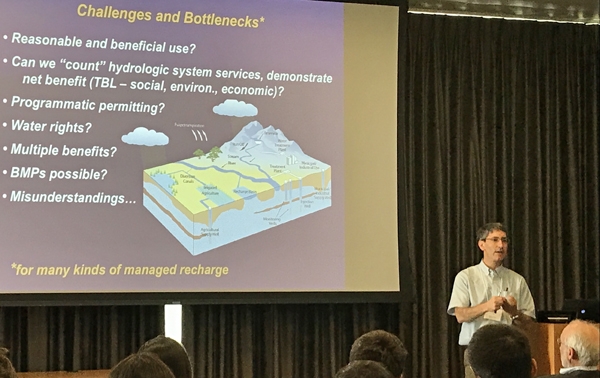Groundwater was the hot topic during the third annual meeting of the UC Water research initiative held in Davis in mid-September. There were thought-provoking presentations from a variety of groundwater experts including Helen Dahlke from UC Davis, Michael Kiparsky from UC Berkeley, and Andrew Fisher from UC Santa Cruz.
In a session on sustainable groundwater management, Dahlke addressed some of the technical issues surrounding groundwater recharge. An overarching theme that emerged was that there is a large variability in conditions – including geology, soils, and surface water sources for recharge – across the state. For example, recharge rates vary and recharge potential varies. So, while progress has been made, there are still a lot of scientific and technical questions to be answered, and researchers continue to pursue those.
During the same session, Fisher and Kiparsky addressed some of the related political and economic issues around groundwater recharge. Fisher laid out the following set of challenges and bottlenecks for groundwater recharge:
- Can or should groundwater recharge be considered to be a beneficial use?: Infiltration and recharge projects that use excess stormwater flows (either from hill slopes or channels) generally need to obtain a water right. The application includes specification of the final "use" of recovered water. This administrative requirement may inadvertently constitute a hurdle to project development that could impede the larger goals of replenishment and improvement to water quality on a regional basis. One potential policy improvement could be changing the benefit associated with infiltration/recharge itself, not subsequent recovery and use.
- Counting hydrologic system services and demonstrating net benefit – socially, economically, environmentally: One way to account for benefits of management actions is to focus on the economics associated with the cost of water supply. But, other benefits from infiltration and recharge can include environmental improvement to connected aquatic systems and support for regional communities. "Triple bottom line" accounting, which includes all of these benefits, provides a stronger measure of sustainability and security than does consideration of economics alone. Incorporating such broad measures into decision-making remains an unsolved challenge.
- Programmatic permitting: Could systems of infiltration/recharge projects be permitted on a programmatic basis, satisfying critical requirements involving safety and environmental impact? Then, individual infiltration/recharge projects could secure additional permits, as may be required, based on local conditions, but without having to make the overall case for programmatic benefits.
- Water rights: Implementing recharge projects raises questions about water rights. For example, in the act of diverting the water, under what conditions is a water right required, and, if so, what kind? If infiltration/recharge is accomplished on land adjacent to a river or stream, for instance, does this require a riparian right or an appropriative right? Water rights tend to be based on a narrow view of benefits and a strong focus on the end use of the water. This presents administrative and operational challenges for infiltration and recharge projects that focus on basin health and sustainability more broadly.
- Encouraging and measuring multiple benefits: Although it is widely recognized that infiltration/recharge can provide multiple benefits, some funding programs exclude specific goal categories. This can make it difficult to fund projects with multiple benefits – it would help if multiple benefits were encouraged and supported more broadly.
- Establishing best management practices: Many groups and individuals are interested in groundwater recharge, but don't know how to get started or what they should try first. Obviously, every site will be different, but are there some things that could be standardized?
- Misunderstandings: There are many different kinds of recharge and therefore a lot of room for misunderstandings based on the language we use and the way we describe the systems. Precise communication presents a challenge for researchers, stakeholders, regulators, and others about options for recharge.
To close out the session, Kiparsky added an important question: to whom do the benefits of groundwater recharge accrue, and on whom do the risks and costs fall? His answer: “if the road to actualizing a quantitative vision of groundwater recharge goes directly through the laws, institutions, and incentives that are in place, then we need to start examining in tandem with the technical proof of concept what those institutional bottlenecks might be and how to unravel them, whether or not they end up being surmountable.”
In other words, California can't afford to wait for the technical feasibility questions to be answered before tackling the social questions when it comes to groundwater recharge.

